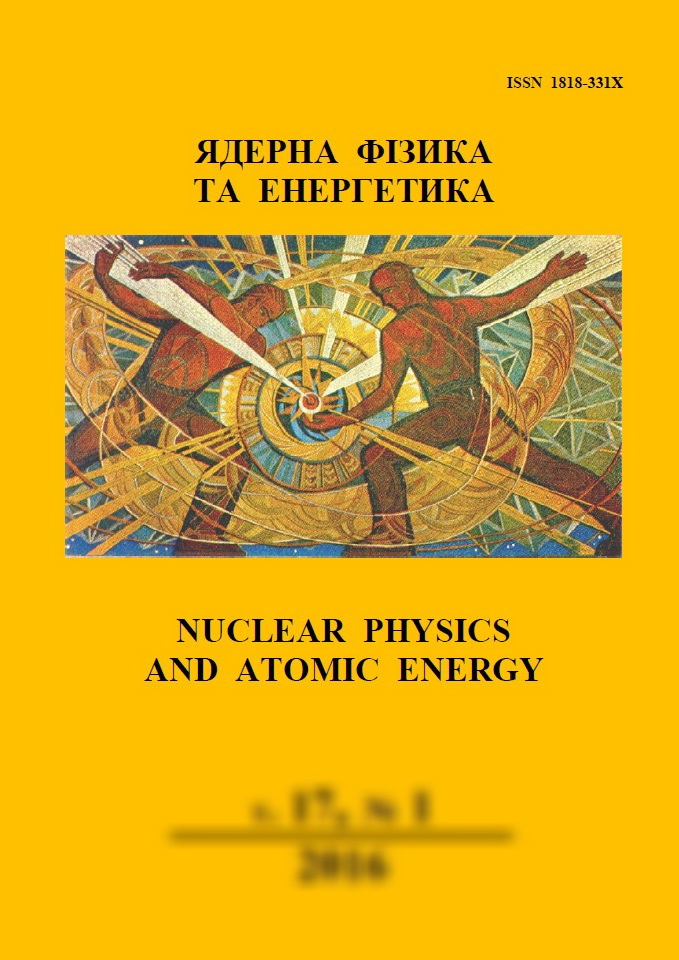 |
ядерна ф≥зика та енергетика
Nuclear Physics and Atomic Energy
ISSN:
1818-331X (Print), 2074-0565 (Online)
Publisher:
Institute for Nuclear Research of the National Academy of Sciences of Ukraine
Languages:
Ukrainian, English
Periodicity:
4 times per year
Open access peer reviewed journal
|
Nucl. Phys. At. Energy 2025, volume 26, issue 3, pages 205-209.
Section: Nuclear Physics.
Received: 20.03.2025; Accepted: 24.05.2025; Published online: 26.09.2025.
 Full text (ua)
Full text (ua)
https://doi.org/10.15407/jnpae2025.03.205
Interaction of protons with nuclei in the Born approximation (II)
Yu. A. Berezhnoy1, V. A. Zolotarev2,*, V. P. Mikhailyuk3
1 V. N. Karazin Kharkiv National University, Kharkiv, Ukraine
2 B. I. Verkin Institute for Low Temperature Physics and Engineering, National Academy of Sciences of Ukraine, Kharkiv, Ukraine
3 Institute for Nuclear Research, National Academy of Sciences of Ukraine, Kyiv, Ukraine
*Corresponding author. E-mail address:
zolotarev@ilt.kharkov.ua
Abstract:
In the framework of the Born approximation, comparison of the previously used approaches, in which analytical expressions for the scattering amplitudes of particles by nuclei were obtained using the expansion of the potential into the series up to the first significant terms, as well as an approach in which such expansion was not performed, are presented. When obtaining analytical expressions for the amplitudes for elastic scattering of protons by nuclei, the second Born approximation with a potential in the Woods-Saxon form, as well as with the potential with a sharp absorption boundary, which was corrected to take into account the blurring of the nuclear surface, are used. Performed theoretical calculations are compared with the available experimental data for the differential cross sections and polarization observables for proton scattering by 40Ca nuclei at 200 MeV energy.
Keywords:
Born approximation, polarization observables.
References:
1. P.E. Hodgson. Nuclear Reactions and Nuclear Structure. W. Marshall, D.H. Wilkinson (Eds.) (Oxford, Clarendon Press, 1971) 661 p.
https://www.amazon.com/Nuclear-Reactions-Structure-International-monographs/dp/0198512619
2. P.E. Hodgson. The Nucleon Optical Model (World Scientific Publishing Co. Pte. Ltd., 1994) 432 p.
https://doi.org/10.1142/2317
3. H. Feshbach. A unified theory of nuclear reactions, II. Ann. Phys. 281 (2000) 519.
https://doi.org/10.1006/aphy.2000.6016
4. Yu.A. Berezhnoy, V.P. Mikhailyuk. Polarization of protons in the optical model. Chinese Physics C 41(2) (2017) 024102.
https://doi.org/10.1088/1674-1137/41/2/024102
5. A.V. Babak, Yu.A. Berezhnoy, V.P. Mikhailyuk. Born approximation for polarization observables at the scattering of protons by 40Ca nuclei. Ukr. J. Phys. 65(5) (2020) 369.
https://doi.org/10.15407/ujpe65.5.369
6. A. Dar, B. Kozlowsky. Polarization in meson-baryon elastic scattering at high energies. Phys. Lett. 20 (1966) 314.
https://doi.org/10.1016/0031-9163(66)90379-9
7. S. Varma. Polarization in elastic scattering at low energies. Nucl. Phys. A 97 (1967) 282.
https://doi.org/10.1016/0375-9474(67)90488-5
8. Yu.A. Berezhnoy, V. A. Zolotarev, V. P. Mikhailyuk. Interaction of protons with nuclei in the Born approximation (I). Nucl. Phys. At. Energy 26(2) (2025) 130. (Ukr)
https://doi.org/10.15407/jnpae2025.02.130
9. W.E. Frahn. Wave mechanics of heavy ion collisions. In: Heavy-Ion, High Spin States and Nuclear Structure. Vol. 1. Proc. of the Int. Extended Seminar, Trieste, Italy, 17 Sep. - 21 Dec. 1973 (Vienna: International Atomic Energy Agency, 1975) p. 157.
https://www.iaea.org/publications/3155/heavy-ion-high-spin-states-and-nuclear-structure-trieste-17-sep-21-dec-1973
10. H. Seifert et al. Effective interaction for 16O(p,p′) and 40Ca(p,p′) at Ep = 200 MeV. Phys. Rev. C 47 (1993) 1615.
https://doi.org/10.1103/PhysRevC.47.1615
